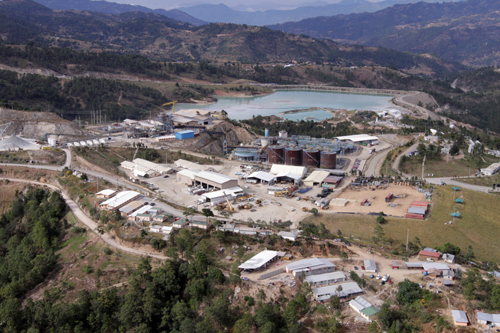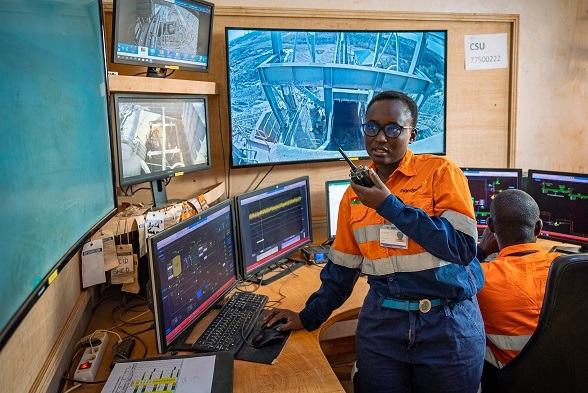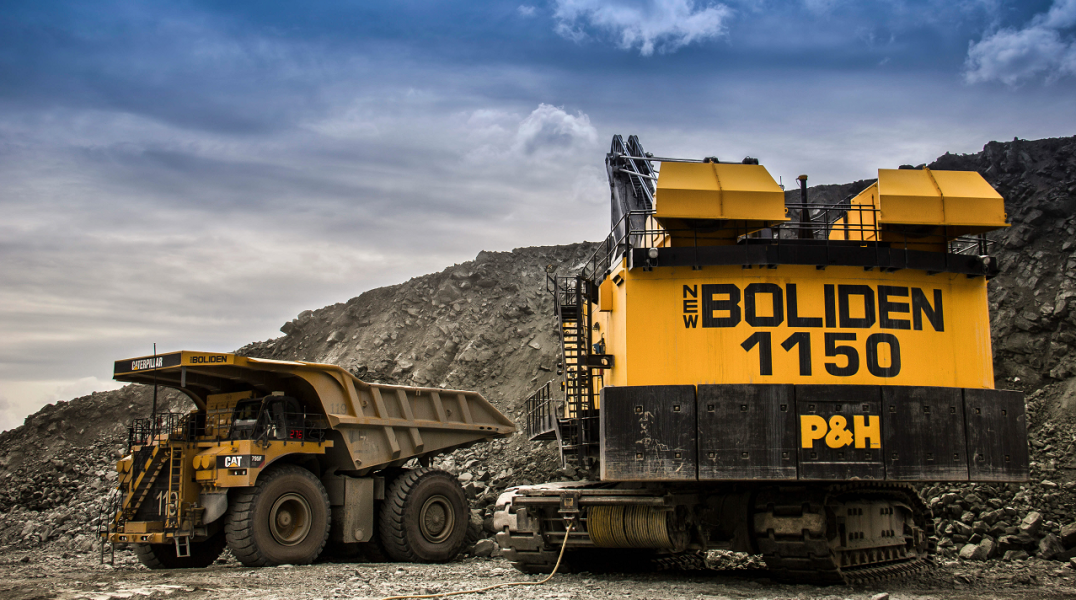
Sustainable opportunities
While Guatemala’s enormous mining wealth is no longer the well-kept secret that it once was it is still an industry very much in its infancy. Through its Marlin Mine operations, Montana Exploradora de Guatemala, a subsidiary of the Canadian firm Goldcorp, is working to ensure the country will soon be able to unlock its potential.
Possessing a land mass of almost 109,000 square kilometres, the Central America country of Guatemala shares its borders with Mexico, Belize, Honduras and El Salvador, as well as the Pacific coastline to the Southwest and a part of the Caribbean coastline to the east.
Boasting a diverse history, a rich and distinctive culture, and areas of immense natural beauty, Guatemala has, in more recent times, become just as well known for its enormous gold potential. Indeed in 2007 one mine alone processed some 1.7 million tonnes of mineral with an average gold content of 4.55 grams per tonne and 84.31 grams of silver per tonne, further confirming the country as a mining destination of particular interest.
Possessing a stable, macroeconomic backdrop, Guatemala is fast earning a reputation as having perhaps the greatest future mining potential of any Central American country. Other factors that are helping to attract the interest of international investors include the free movement of goods and trade, and a local labour force with a reputation for being hard working, fast learners.
Spanning the boundaries of the San Miguel Ixtahuacán and Sipacapa, located in San Marcos, the Marlin Mine was originally discovered in 1998 by two Guatemalan geologists. Acquired in July 2002 by Canadian Company Glamis Gold, it was they who, in conducting an exploration study, determined that the mine held a projected 1.4 million ounces of gold.
This projection spurred the Ministry of Energy and Mines of Guatemala into issuing a licence for the development and operation of the Marlin project, on 27 November 2003. Following the successful completion of the construction phase in the third quarter of 2005, the mine began producing gold and silver before the turn of the year.
During the three years between 2003 and 2006 approximately $300 million was invested into the operator’s exploration activities and overall preparations for exploitation. It was then in 2009 that Goldcorp invested an additional $69 million into the operation, with a similar figure being ploughed into the business in 2010. Such is Goldcorp’s commitment to the long-term success of the project that it intends to invest a further $150 million into Marlin Mine by 2014.
It is not just the mine that is benefiting from such investment and commitment however. Indeed the ripple effect created by this has spread throughout businesses in the local community with Marlin Mine today having more than 1000 suppliers, a figure that is helping to generate contracts worth over $907 million.
“One of the first things we recognised about this mine and what makes it so unique,” explains Marlin Mine General Manager, Christian Roldan, “is just how well the ore itself responds to metallurgical treatments. When it comes to gold we have extremely high recovery rates of about 98 percent recovery and more than 90 percent for silver. We also benefit from the fact that Marlin is located in a very strong mining district where, to this day, we continue to uncover new resources around the main Marlin vein.”
Average annual production at the mine is today estimated as being 250,000 ounces of gold and around 3.5 million ounces of silver, with current reserves exceeding 2.5 million ounces of gold and 36 million ounces of silver. In the five years between 2005 and 2010 it has been calculated that some 1.2 million ounces of gold, equivalent to over $1.1 billion, that originated from the mine was exported along with 18.2 million tonnes of silver, which generated $299.3 million in export revenues.
The production process of the Marlin Mine is divided into four phases, these being exploration, construction, operation and production, and technical closure and reclamation. “At present,” Roldan continues, “there are three main underground areas that we are mining. In order to extract the full potential of what the mine has to offer we have had to overcome a number of challenges. These have included creating ventilation systems for both on-going and future underground activities and establishing strong water controls around the mine site.”
Strong environmental controls have been a feature of the mine site since it first opened. Today these controls include the use of emergency response teams that are on call at all times of day to respond to all manner of events. These include responding to signs of increased sodium or sulphite levels in the surrounding water network or dealing with any issues that may arise during the transportation of hazardous materials. Such is the skill of the mine’s emergency teams that they were even called in to assist in the rescue and recovery efforts that followed the earthquake that struck the San Marcos area in November 2012.
In 2012, Montana Exploradora de Guatemala commissioned the building of a tail filtering plant near to the mine. The concept for the plant came about as a solution to how the operators could reclaim the open pit section of Marlin Mine that is no long in operation. The plant’s core function today is to dry the tailings from the mine in order for them to be used to fill pipes and cover the decommissioned pit wall in order to avoid further erosion or drainage.
The immediate future of Marlin Mine revolves around what Roldan calls an extensive aspiration programme. “We presently have a number of aggressive exploration programmes underway in many areas of the district surrounding the mine and we have been greatly encouraged by the results we have seen. This gives us great hope for extending the Marlin Mine network further into these parts of the region.”
In the meantime the operators also remain committed to setting a strong example of what responsible modern mining can bring to the country in the decades ahead, “On average,” national executive director, Mario Marroquin concludes, “mining in countries such as Chile and Peru accounts for as much as 12 percent of their annual GDP, while here in Guatemala that figure is more like two percent. If we were able to bring this up to just six percent, I believe the results of that would be more than enough to convince a great deal more people to begin accepting the industry and help them realise just how many positive benefits a strong, responsible mining sector could bring to the country.”
Supporting development
The legacy left behind by Marlin Mine in Guatemala is something of huge importance to its operators, Montana Exploradora de Guatemala, and is what drives its work in the field of corporate social responsibility.
Long before it commenced operations at its Marlin Mine asset, Goldcorp made a commitment to not only respect the cultural values of the local communities of San Miguel and Sipacapa, but also to support the sustainable development of the area.
It remains the company’s aim to seek out and establish strategic alliances throughout the region in order to promote its dedication to improve the lives of the local population and generate sustainable prosperity that lasts beyond the lifetime of the mine.
The operators of Marlin Mine, Montana Exploradora de Guatemala, a subsidiary of Goldcorp, are very much pioneers within the country of Guatemala. “We have known since day one,” Marlin Mine General Manager, Christian Roldan says, “that by being situated on indigenous land it has been fundamental to build strong relationships with local communities. By sitting down and listening to their concerns and needs we quickly found that job creation was a big issue for them. Today we are proud to say that approximately 90 percent of our workforce is Guatemalan, with 60 percent of these being people from the local area.”
Being a 24 hours a day, 365 days a year type operation, logistics is a hugely vital ingredient in the mines success. Once again the local community has become a major strategic partner in this area of the business. “We take great pride in the fact that over 68 percent of our suppliers are local providers,” enthuses materials manager, Pedro Richmagui.
In getting to this position, the mine operators have worked tirelessly to develop local businesses and to improve their understanding of mining and how it will become even more important to Guatemala in the years to come. “A good example of our work in this field,” Richmagui continues, “is how we have helped develop local transport companies, bringing them up to a level of operational excellence that means that when the day comes that the mine is no longer in operation the community is left with a strong enterprise that can then pitch itself to other organisations.”
While local communities have already experienced the benefits that mining can bring to the country, the perception of mining amongst the wider population of Guatemala remains somewhat divided. It is for this reason that the operators of Marlin Mine continue to make a concerted effort to bring people, groups and agencies together in order to highlight how a prosperous mining industry can benefit Guatemala in the long term.
“While there is a large number of people who support what we are doing and understand the vital role that mining has to play in enhancing the economy of a country by means of greater investment and revenue flows, one of our core missions is to help instil this belief in the rest of the population of Guatemala,” states national executive director, Mario Marroquin. “This was never going to be a quick process, however trends do suggest that support for mining is slowly growing.”
While support for mining continues to build, other challenges lay ahead for Marlin Mine’s operators, in particular the question of what kind of legacy the mine will leave behind once it has closed. This is a question that has been posed not only to Montana Exploradora de Guatemala, but also to Guatemala’s local politicians and its national government.
“In planning for the future of the area around the mine,” explains corporate social responsibility director, Gustavo Cabrera, “we are looking at a host of factors, from ensuring the long term wellbeing of the local communities to making sure that they have the tools needed to bring economic activity to the area after we have gone. On-going efforts involve closing the gaps that exist in education, healthcare and employment in order to boost the economy.”
Montana Exploradora de Guatemala has played a big role in various social development projects for the better part of a decade, particularly in the fields of infrastructure, education, productivity, community relations and healthcare. Through its Sustainable Development Department it has executed over 2,000 community development interventions and more than 150 projects that have directly supported new and existing infrastructure found among the local communities.
While Guatemala is slowly making positive steps towards greater social and economic prosperity the country does still suffer from significant shortcomings when it comes to education and healthcare, a fact that has long been a major obstacle in raising the rate of national productivity. Montana Exploradora de Guatemala understands that education is the cornerstone in the development of communities and as such it has striven to support the building and development of schools, school kitchens, computer centres and sports parks. To date the company has driven almost 300 initiatives that share the same goal of improving the education standards and experiences of those within the municipalities of San Miguel, Sipakapa, Malacatancito and Tejutla.
In terms of the help the mine’s operators have provided towards the improvement of healthcare in the region it has aided in the building and equipping of the Permanent Attention Centre (CAP) in San Miguel. The creation of the CAP is a prime example of Goldcorp’s Sustainable Prosperity programme being put into action, assisting in the company’s mission to be recognised as a responsible corporate citizen.
The CAP is today seen as an example of partnership between sectors. In addition to the efforts of Montana Exploradora de Guatemala, the municipality of San Miguel provided the land and the Ministry of Health remains responsible for its operation and good performance.
The centre itself is equipped with the very latest technology that is used in a range of medical fields. The investment that all parties have made in the CAP means that today local Guatemalan communities are able to access better health care than they could previously receive.
In its role as a responsible mining company, Montana Exploradora de Guatemala has made sure to integrate Goldcorp’s Environmental Policy into its Marlin Mine operations. As part of this policy the operators are committed to the responsible use of water, waste management, carrying out regular environmental monitoring, reforestation, promoting environmental education and the reclamation of mined areas.
A sophisticated closed circuit system means that approximately 99 percent of the water used at Marlin Mine is recycled and reused in other areas of the mining process, while processed water, or sludge, is treated onsite before being discharged into the tailings and then pumped back for reuse. There are two water treatment plants in the vicinity of the mine itself, one of which treats aerobic sewage while the other processes it into tunnel water that is then safe to release back into the environment.
Montana Exploradora de Guatemala has worked hard to establish and implement regular environmental monitoring programmes that take place around Marlin Mine. These programmes look to identify and monitor terrestrial and aquatic biological resources and wildlife with the aim of helping to maintain Guatemala’s ecological balance.
Soil monitoring is conducted annually to identify vegetation, macronutrients and nematodes, samples of which are in turn analysed at the laboratories of agronomy at the University Of San Carlos Of Guatemala. Meanwhile, studies of local flora and fauna are conducted by teams of ornithologists, mammalogists, herpetologists and entomologists in order to catalogue species of plants and animals and monitor their respective population numbers.
To date Montana Exploradora de Guatemala has helped in the reforestation of more than 300 hectares of land in the municipalities of San Miguel and Sipakapa, while more than 50 hectares of land was reforested between the two municipalities in 2011 alone. Indeed the operators are playing a core role in one of the Guatemalan government’s most important environmental schemes, that being the Forest Plan. The aim of this plan is to reforest an area of 199.5 hectares, of which over 100 hectares have already been covered.
From a social perspective, Montana Exploradora de Guatemala’s track record in recent years for generating local jobs cannot be disputed, what with some 10,000 direct and indirect jobs created through the mine's operations, however it is aware that the task at hand now involves building up the capabilities of these same people in preparation for when the mine does close and the possibility that alternative employment may be required.
“One of our responsibilities, as we see it, is to provide our local employees and communities with the skills and expertise that they will need to take on other roles in the future, both inside and out of the mining sector,” Cabrera highlights. “We know, for instance, that the land around the mine has great agricultural potential. Therefore, what we have been doing is working to establish relationships with big businesses such as Wal-Mart in Guatemala and in Mexico in the hope of creating a scenario in which local Guatemalan agricultural companies can one day earn long-term supplier contracts.”
On top of creating employment opportunities, Marlin Mine has also contributed hugely to the development of Guatemala through the paying of taxes and royalties during its lifetime. Indeed the operators of the mine are recognised today as being one of the biggest tax payers in all of the country.
The Mining Act of Guatemala specifies that for each mining operation, one percent of the total gross sales from the production of gold and silver must be divided equally between the government of the country and the municipality of San Miguel. In its near decade of activity in the country Montana Exploradora de Guatemala has been more than happy to contribute such royalties, the proceeds of which have already begun to create a long lasting legacy by funding crucial infrastructure improvements within the area and beyond.
Written by Will Daynes, research by Candice Nice



 Goldcorp-MarlinMine-AM.Mining-June13-Bro-s.pdf
Goldcorp-MarlinMine-AM.Mining-June13-Bro-s.pdf









